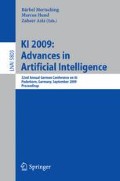Abstract
Analogy plays a very important role in human reasoning. In this paper, we study a restricted form of it based on analogical proportions, i.e. statements of the form a is to b as c is to d. We first investigate the constitutive notions of analogy, and beside the analogical proportion highlights the existence of two noticeable companion relations: one that is just reversing the change from c to d w. r. t. the one from a to b, while the last one called paralogical proportion expresses that what a and b have in common, c and d have it also. Characteristic postulates are identified for the three types of relations allowing to provide set and Boolean logic interpretations in a natural way. Finally, the solving of proportion equations as a basis for inference is discussed, again emphasizing the differences between analogy, reverse analogy, and paralogy, in particular in a three-valued setting, which is also briefly presented.
Access this chapter
Tax calculation will be finalised at checkout
Purchases are for personal use only
Preview
Unable to display preview. Download preview PDF.
References
Winston, P.H.: Learning and reasoning by analogy. Com. ACM 23, 689–703 (1980)
Gentner, D.: The Mechanisms of Analogical Learning. In: Similarity and Analogical Reasoning, pp. 197–241. Cambridge University Press, Cambridge (1989)
Davies, T.R., Russell, S.J.: A logical approach to reasoning by analogy. In: IJCAI 1987, pp. 264–270. Morgan Kaufmann, San Francisco (1987)
Sowa, J.F., Majumdar, A.K.: Analogical reasoning. In: Ganter, B., de Moor, A., Lex, W. (eds.) ICCS 2003. LNCS, vol. 2746, pp. 16–36. Springer, Heidelberg (2003)
Schmid, U., Gust, H., Kühnberger, K., Burghardt, J.: An algebraic framework for solving proportional and predictive analogies. In: Eur. Conf. Cogn. Sci., pp. 295–300 (2003)
Aamodt, A., Plaza, E.: Case-based reasoning; foundational issues, methodological variations, and system approaches. AICom 7(1), 39–59 (1994)
Klein, S.: Culture, mysticism & social structure and the calculation of behavior. In: Proc. Europ. Conf. in AI (ECAI), pp. 141–146 (1982)
Lepage, Y.: Analogy and formal languages. In: Proc. FG/MOL 2001, pp. 373–378 (2001), http://www.slt.atr.co.jp/~lepage/pdf/dhdryl.pdf.gz
Miclet, L., Prade, H.: Logical definition of analogical proportion and its fuzzy extensions. In: Proc. NAFIPS. IEEE, New York (2008)
Prade, H.: Proportion analogique et raisonnement à partir de cas. In: Rencontres Francophones sur la Logique Floue et ses Applications, Cépaduès, pp. 296–303 (2008)
Gentner, D., Holyoak, K.J., Kokinov, B. (eds.): The Analogical Mind: Perspectives from Cognitive Sciences. MIT Press, Cambridge (2001)
Stroppa, N., Yvon, F.: Analogical learning and formal proportions: Definitions and methodological issues. ENST Paris report (2005)
Miclet, L., Bayoudh, S., Delhay, A.: Analogical dissimilarity: definition, algorithms and two experiments in machine learning. JAIR 32, 793–824 (2008)
Hullermeier, E.: Case-Based Approximate Reasoning. Theory and Decision Library. Springer, New York (2007)
Author information
Authors and Affiliations
Editor information
Editors and Affiliations
Rights and permissions
Copyright information
© 2009 Springer-Verlag Berlin Heidelberg
About this paper
Cite this paper
Prade, H., Richard, G. (2009). Analogy, Paralogy and Reverse Analogy: Postulates and Inferences. In: Mertsching, B., Hund, M., Aziz, Z. (eds) KI 2009: Advances in Artificial Intelligence. KI 2009. Lecture Notes in Computer Science(), vol 5803. Springer, Berlin, Heidelberg. https://doi.org/10.1007/978-3-642-04617-9_39
Download citation
DOI: https://doi.org/10.1007/978-3-642-04617-9_39
Publisher Name: Springer, Berlin, Heidelberg
Print ISBN: 978-3-642-04616-2
Online ISBN: 978-3-642-04617-9
eBook Packages: Computer ScienceComputer Science (R0)

